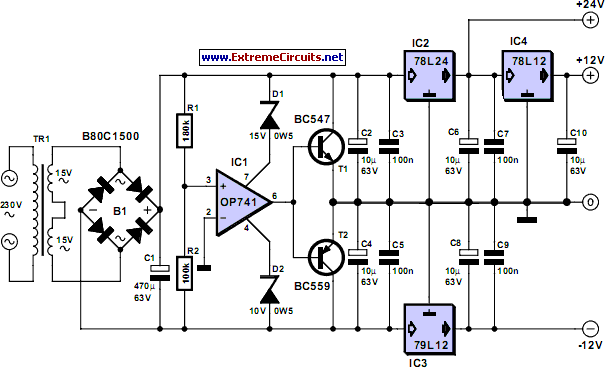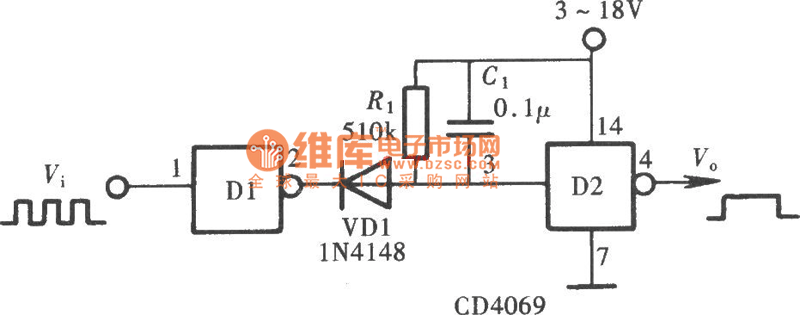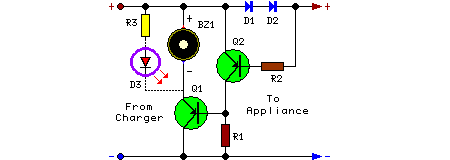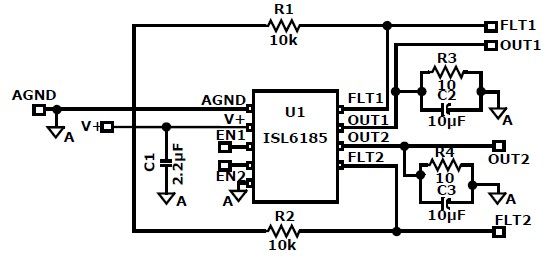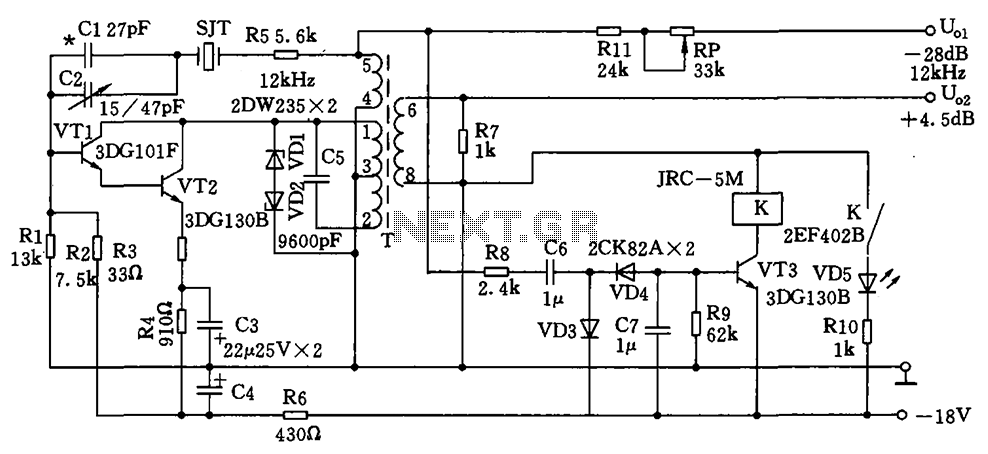
East Shi IDS-2000F STB switching power supply circuit
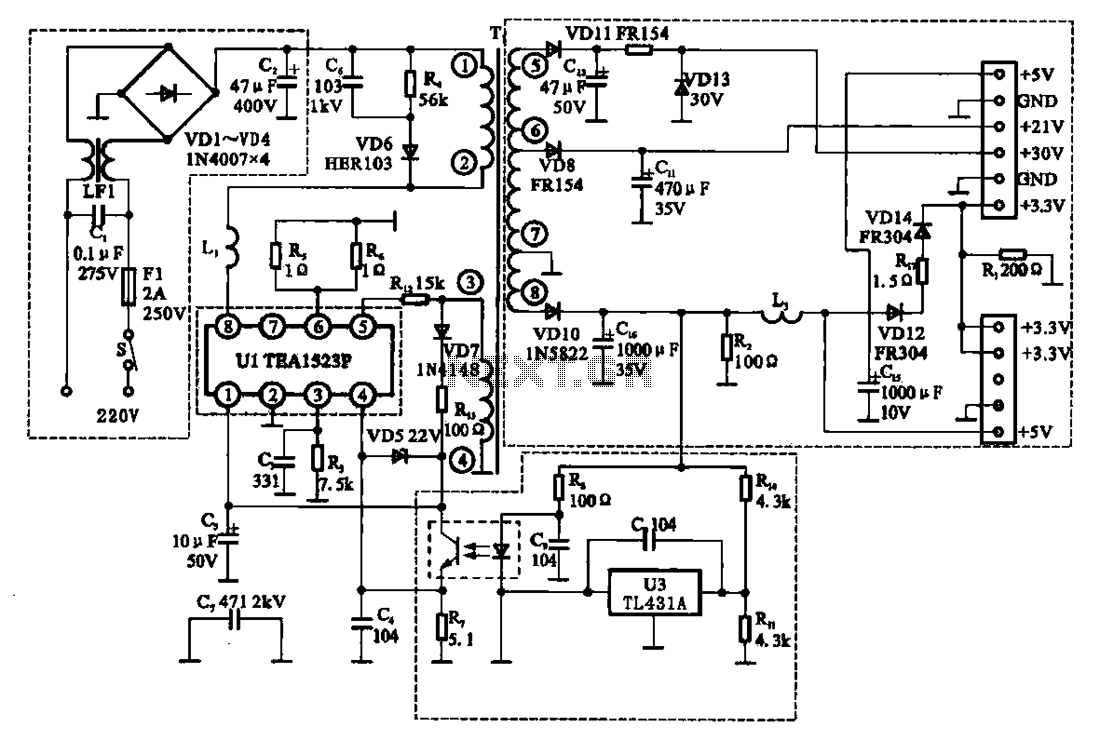
The East Shi IDS-2000F STB switching power supply circuit primarily consists of an AC input circuit, a switching oscillation circuit, an output circuit, and a secondary steady voltage control circuit. The AC input circuit includes a switch (S), fuse (F1), mutual inductance filter (C1), inductor (LF1), and a bridge rectifier circuit (VD1-VD4). Its function is to filter the AC 220V input voltage and rectify it into a DC voltage of 300V, with C2 acting as the smoothing capacitor. The switching and oscillation control circuit is integrated within the TEA1523P (U1), which operates at 30V DC. The primary winding of transformer (T1) is connected to U1, allowing it to control the oscillation state via positive feedback. The secondary output circuit of transformer T1 provides multiple output voltage levels, including +5V, +21V, +3V, and +3.3V. The voltage regulator circuit is connected to the +5V output, where resistors R14 and R11 form a voltage divider. U3 serves as an error detection and amplifier, sending the error signal back to U1 through photoelectric coupling to control the oscillation output.
The East Shi IDS-2000F STB switching power supply circuit is a well-structured design that efficiently manages power conversion and regulation. The AC input circuit serves as the initial stage, where the AC voltage is filtered and converted to a high DC voltage. The inclusion of a fuse (F1) ensures protection against overloads, while the mutual inductance filter (C1) helps to eliminate high-frequency noise, enhancing the reliability of the power supply.
The switching oscillation circuit, utilizing the TEA1523P integrated circuit, is critical for maintaining the desired operational efficiency. This component generates the necessary switching signals to drive the transformer (T1), thus enabling the conversion of high-voltage DC into the required lower voltage outputs. The feedback mechanism, facilitated by the positive feedback winding, ensures that the oscillation frequency remains stable and responsive to load variations.
In the secondary output circuit, the multiple output voltages are achieved through the use of a switching transformer. Each output is rectified to provide stable voltage levels suitable for various applications, such as powering digital circuits, microcontrollers, and other electronic devices. The design incorporates voltage regulation to maintain output stability despite fluctuations in load or input voltage.
The voltage regulator circuit plays a vital role in ensuring that the +5V output remains consistent. The voltage divider formed by resistors R14 and R11 sets a reference level for the error amplifier (U3), which monitors the output voltage. Any deviation from the set point generates an error signal that is fed back to the TEA1523P (U1) via photoelectric coupling. This feedback loop allows for real-time adjustments to the oscillation output, ensuring that the power supply operates within specified voltage limits.
Overall, the East Shi IDS-2000F STB switching power supply circuit exemplifies an efficient and robust design, capable of delivering multiple output voltages with high reliability and stability.East Shi IDS-2000F STB switching power supply circuit East Shi IDS -2000F STB switching power supply circuit mainly by the AC input circuit, switching oscillation circuit, outp ut circuit and a secondary steady pressure control circuit and the like, as shown in Figure 2. 63. (1) AC input circuit AC input circuit is a switch S, fuse Fl, mutual inductance filter cl, LF1 and bridge rectifier circuit (VDI-VD4) and the like, its function is to filter the AC 220V input voltage and interference rectifier into a DC voltage of 300V, C2 to the smoothing capacitor. (2) switch and oscillation control circuit switches and the oscillation control circuit are integrated in Ul TEA1523P among the 30V DC via the switch of the primary winding of the transformer Ti O ~ to Ul foot power switch is integrated in Ul among the positive feedback winding ~ feet U1 provides power and positive feedback voltage to Ul access switch oscillation state.
(3) secondary output circuit switching transformer Ti attack multiple sets of output level, the rectifier output +5 V, + 21 V, + 3V and +3.V voltages. (4) regulator circuit voltage regulator circuit connected to the output of + 5V, Rl4, R11 constitute a voltage divider circuit, U3 to error detection and error amplifier, it will error signal by the photoelectric coupling of feedback to Ul feet, of Ul oscillation output controlled.
The East Shi IDS-2000F STB switching power supply circuit is a well-structured design that efficiently manages power conversion and regulation. The AC input circuit serves as the initial stage, where the AC voltage is filtered and converted to a high DC voltage. The inclusion of a fuse (F1) ensures protection against overloads, while the mutual inductance filter (C1) helps to eliminate high-frequency noise, enhancing the reliability of the power supply.
The switching oscillation circuit, utilizing the TEA1523P integrated circuit, is critical for maintaining the desired operational efficiency. This component generates the necessary switching signals to drive the transformer (T1), thus enabling the conversion of high-voltage DC into the required lower voltage outputs. The feedback mechanism, facilitated by the positive feedback winding, ensures that the oscillation frequency remains stable and responsive to load variations.
In the secondary output circuit, the multiple output voltages are achieved through the use of a switching transformer. Each output is rectified to provide stable voltage levels suitable for various applications, such as powering digital circuits, microcontrollers, and other electronic devices. The design incorporates voltage regulation to maintain output stability despite fluctuations in load or input voltage.
The voltage regulator circuit plays a vital role in ensuring that the +5V output remains consistent. The voltage divider formed by resistors R14 and R11 sets a reference level for the error amplifier (U3), which monitors the output voltage. Any deviation from the set point generates an error signal that is fed back to the TEA1523P (U1) via photoelectric coupling. This feedback loop allows for real-time adjustments to the oscillation output, ensuring that the power supply operates within specified voltage limits.
Overall, the East Shi IDS-2000F STB switching power supply circuit exemplifies an efficient and robust design, capable of delivering multiple output voltages with high reliability and stability.East Shi IDS-2000F STB switching power supply circuit East Shi IDS -2000F STB switching power supply circuit mainly by the AC input circuit, switching oscillation circuit, outp ut circuit and a secondary steady pressure control circuit and the like, as shown in Figure 2. 63. (1) AC input circuit AC input circuit is a switch S, fuse Fl, mutual inductance filter cl, LF1 and bridge rectifier circuit (VDI-VD4) and the like, its function is to filter the AC 220V input voltage and interference rectifier into a DC voltage of 300V, C2 to the smoothing capacitor. (2) switch and oscillation control circuit switches and the oscillation control circuit are integrated in Ul TEA1523P among the 30V DC via the switch of the primary winding of the transformer Ti O ~ to Ul foot power switch is integrated in Ul among the positive feedback winding ~ feet U1 provides power and positive feedback voltage to Ul access switch oscillation state.
(3) secondary output circuit switching transformer Ti attack multiple sets of output level, the rectifier output +5 V, + 21 V, + 3V and +3.V voltages. (4) regulator circuit voltage regulator circuit connected to the output of + 5V, Rl4, R11 constitute a voltage divider circuit, U3 to error detection and error amplifier, it will error signal by the photoelectric coupling of feedback to Ul feet, of Ul oscillation output controlled.
